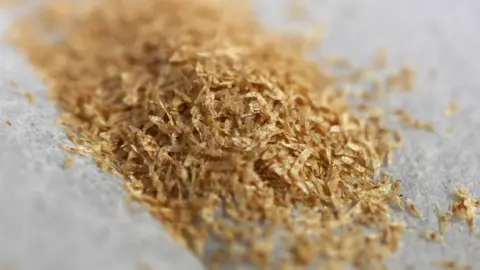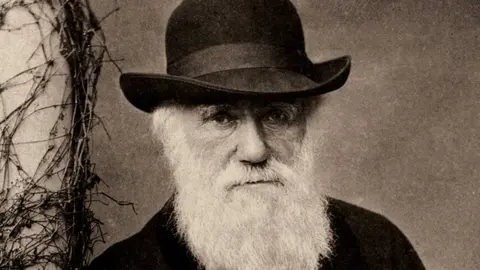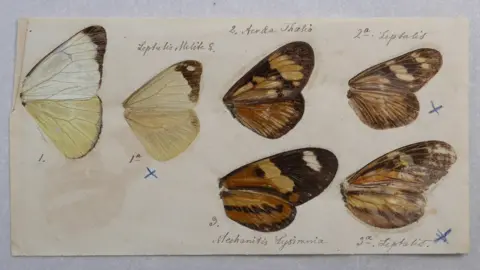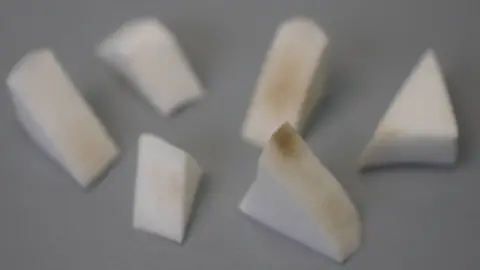Charles Darwin's dwarf kidney beans cleaned and catalogued
Thousands of items collected by Charles Darwin, including 392 dwarf kidney beans, are being made available online.
Alison Pearn, head of The Darwin Correspondence Project, said the aim was to document and photograph the "weird and wonderful" items.
As well as cleaning the beans for the archive, Brazilian butterfly wings, microscopic pollen grains, pony and beard hair have been catalogued.
Ms Pearn said the archive would be made as "widely available" as possible.
Work started in 1974 to document and find his letters, with the digitisation beginning in 2013.
So far about 90,000 images have been uploaded with 4,000 still to conserve and 36,000 images to take.
It should be finished by the end of 2022.
 Syndics of Cambridge University Library
Syndics of Cambridge University LibraryAnna Johnson, conservation and collection care manager at Cambridge University Library (CUL), said researchers would be able to access his material online, meaning everything would be "preserved for much longer".
"This applies to other specimens in the same collection," she said. "We have butterfly wings sent from Brazil, we have packets of microscopic pollen grains, exoskeletons from Brazil, long horned caddisfly larvae, pony hair and beard hair sent in by a member of the public."

Who was Charles Darwin?
 Cambridge University Library
Cambridge University LibraryCharles Darwin was an English scientist - naturalist, geologist and biologist - best known for his work on the theory of evolution by natural selection.
His groundbreaking work, On the Origin of Species, was published in 1859 and changed the way we think about the natural world.
At the time it was highly controversial, as it provided evidence that certain animals had evolved from others over time, apparently best fit for their surroundings. This was at odds with the long-established religious belief that God had created all creatures, great and small.
Darwin studied the divergence of 18 species of passerine birds ["Darwin's finches"] in the Galápagos Islands, in the Pacific. He noted the remarkable diversity in beak form and function.
"Light will be thrown on the origin of man and his history," he wrote, as a result.
In his second seminal publication, 1871's The Descent of Man, Darwin applied his theory to the evolution of humans, suggesting we share a common ancestor with the great apes.
(Homo sapiens are now believed to have evolved alongside orangutans, chimpanzees, bonobos, and gorillas.)
Simple yet profound, his theory is one of the most influential scientific ideas ever conceived.
Even today, its conclusions and implications have an impact on religion, politics, economics and art, as well as our understanding of the world around us.

Ms Pearn said a video posted by the university on Twitter about the 392 dwarf kidney beans being cleaned for digitalisation received more than 168,000 views, making it one of its most popular posts.
The beans were sent to Darwin by gardener Henry Coe.
"It wasn't just information he was asking for from his correspondents, he asked and was sent specimens, bits and pieces, the weird and the wonderful," she said.
 Syndics of Cambridge University Library
Syndics of Cambridge University LibraryEmma Nichols, book and paper conservator at CUL, said cleaning the kidney bean was the "most unusual" item she had worked on.
She said she had to find a way to stop it "skidding across my bench".
All 392 beans were kept in packets.
 Syndics of Cambridge University Library
Syndics of Cambridge University Library"I had colleagues walking past my bench asking what I was working on," she said.
"It was making happy little squeaking noises.
"It's opened everyone's eyes to how amazing this collection is and the variety of material that is in the archive."

Find BBC News: East of England on Facebook, Instagram and Twitter. If you have a story suggestion email [email protected]
